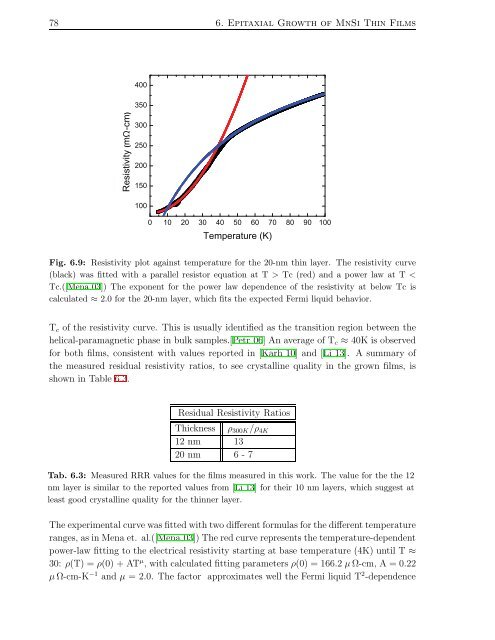As and Epitaxial-Growth MnSi Thin Films - OPUS Würzburg
As and Epitaxial-Growth MnSi Thin Films - OPUS Würzburg
As and Epitaxial-Growth MnSi Thin Films - OPUS Würzburg
Create successful ePaper yourself
Turn your PDF publications into a flip-book with our unique Google optimized e-Paper software.
78 6. <strong>Epitaxial</strong> <strong>Growth</strong> of <strong>MnSi</strong> <strong>Thin</strong> <strong>Films</strong><br />
400<br />
350<br />
Resistivity(mΩ-cm)<br />
300<br />
250<br />
200<br />
150<br />
100<br />
0 10 20 30 40 50 60 70 80 90 100<br />
Temperature (K)<br />
Fig. 6.9: Resistivity plot against temperature for the 20-nm thin layer. The resistivity curve<br />
(black) was fitted with a parallel resistor equation at T > Tc (red) <strong>and</strong> a power law at T <<br />
Tc.([Mena 03]) The exponent for the power law dependence of the resistivity at below Tc is<br />
calculated ≈ 2.0 for the 20-nm layer, which fits the expected Fermi liquid behavior.<br />
T c of the resistivity curve. This is usually identified as the transition region between the<br />
helical-paramagnetic phase in bulk samples.[Petr 06] An average of T c ≈ 40K is observed<br />
for both films, consistent with values reported in [Karh 10] <strong>and</strong> [Li 13]. A summary of<br />
the measured residual resistivity ratios, to see crystalline quality in the grown films, is<br />
shown in Table 6.3.<br />
Residual Resistivity Ratios<br />
Thickness ρ 300K /ρ 4K<br />
12 nm 13<br />
20 nm 6 - 7<br />
Tab. 6.3: Measured RRR values for the films measured in this work. The value for the the 12<br />
nm layer is similar to the reported values from [Li 13] for their 10 nm layers, which suggest at<br />
least good crystalline quality for the thinner layer.<br />
Theexperimentalcurvewasfittedwithtwodifferentformulasforthedifferenttemperature<br />
ranges, asinMena et. al.([Mena 03])Theredcurve represents thetemperature-dependent<br />
power-law fitting to the electrical resistivity starting at base temperature (4K) until T ≈<br />
30: ρ(T) = ρ(0) + AT µ , with calculated fitting parameters ρ(0) = 166.2 µΩ-cm, A = 0.22<br />
µΩ-cm-K −1 <strong>and</strong> µ = 2.0. The factor approximates well the Fermi liquid T 2 -dependence
















